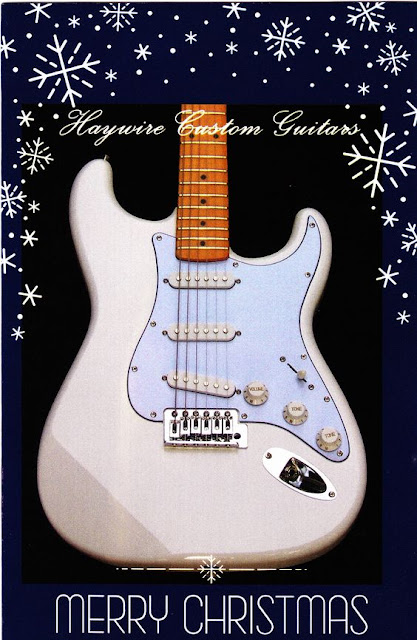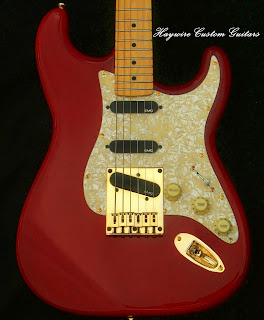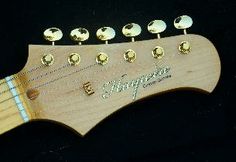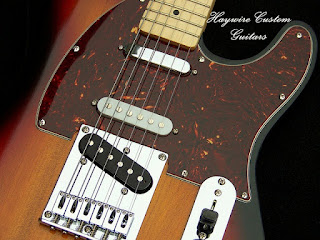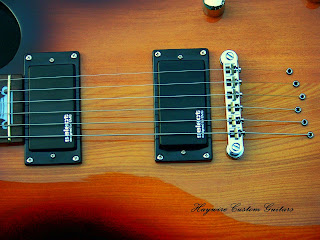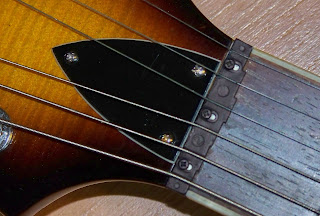Haywire Custom Guitars Blog-A blog about guitars,Haywire guitars custom shop, guitar neck shaves, guitar terms, guitar improvements, guitar modifications, guitar repairs, guitar necks, guitar bodies, custom guitars,electric guitars, Fender guitars, Stratocasters, Telecasters guitar tips and guitar resources.Great Tips and Ideas for Guitar Players! Truss rod adjustments, guitar tune-ups, repairs on guitars
Saturday, December 24, 2016
Saturday, September 3, 2016
Haywire Custom Shop 08/29/2016: Gibson Vintage 1972 Les Paul Snapped Headstock Repair Photos
1972 Gibson Les Paul Snapped Headstock Repair Photos
Sometimes it's better to repair a guitar you already own instead of buying a new one. In this case 10 years after the accident occurred the owner, Russ met up with me at the Haywire Custom Guitar Shop and we talked about resurrecting his beautiful
1972 one owner Vintage Les Paul. Russ left and I went to work. It was back to normal in 2 days and Russ will be very happy to have his guitar home again in playing condition! Rick Mariner - Haywire Custom Guitars
Labels:
<img src=" http://www.haywirecustomguitars.com/default.html" alt=" Haywire Custom Guitars USA">,
1972 Gibson Les Paul Snapped Headstock Repair Photos
Location:Myrtle Beach,SC
Myrtle Beach, SC, USA
Friday, May 20, 2016
Haywire Shredneck Custom Guitar
The Haywire Shredneck Custom is a pickers delight thanks to a fast neck that let's you bend your way from here to Nashville. In 1982, Haywire was on the forefront
with some of the first prototype models for this versatile design.
This guitar takes the traditional single cutaway design with the Humbucker Tele bridge, and combines it with the three pickup configuration found on traditional double cutaway solid body guitars, giving you the most distinctive sounds of both guitars in one fine instrument.
The pickup combination of the Lollar Imperial Low Wind in the bridge, Duncan Mini-Humbucker at the neck, and Lollar Vinatge Blond in the middle gives you everything from that unmistakable country twang to great rock sounds from Hendrix to Clapton, and everything in between. Any other pickups made in the USA are available as option on this guitar.
The following combinations are available on the 5 way switch: Bridge pickup only, bridge and center pickup, center pickup only, center and neck pickup, and neck pickup only. Haywire adds our exclusive:
Haywire SubSound-2 (Seven Sound Switch) option
to this guitar, giving you the two additional combinations of the neck and bridge pickup together or all three pickups together.Haywire also includes the Haywire Treble Bleed Circuit, which allows your high frequencies to shine through at lower volume settings.
Every Shredneck Custom is built to each individual customer specifications with unlimited custom wiring choices, component selections, and a wide selection of quality Warmoth necks equipped with stainless steel frets that provide exceptionally long wear and silky smooth bends. The result is a guitar that was built to fit in your hands with the ability to produce virtually any sound that you can imagine.
Haywire Shredneck Custom Features:
3-
5-
Unique Lollar pickup combination
Haywire's exclusive Haywire SubSound-2 (Seven Sound Switch)
Haywire Treble Bleed Circuit
Your choice thickness of Maple neck with satin nitro finish
9.5", 12" or compound radius may be selected radius Maple fret board
Stainless Steel Frets
Hard shell case included
Free worldwide shipping
Labels:
custom,
custom guitar by Haywire,
Custom guitar modifications,
Guitar repair Haywire Custom Guitars,
http://www.haywirecustomguitars.com,
http://www.haywirecustomguitars.com/shredneckcustom.html
Location:Myrtle Beach,SC
Myrtle Beach, SC, USA
Sunday, April 24, 2016
Over 1,300 Haywire Custom Guitar Photos!
Haywire Custom Guitars Photo Gallery
One has to wonder what goes through the mind of an artist as a creation comes from conception going to perception then to perfection. Does it start with an idea, an experience, or a need ? Maybe about one clear moment of and an uninhibited positive attitude? It’s the artist’s motivation. Along the way there many learning experiences. These are mostly training exercises. An artist is dedicated to a focus on the result and it helps to form and strengthen themselves as an artist. Wood, nickel, steel and copper are some of earth’s most primitive materials pieced together into the artist’s ideas, imagination and eye for beauty. For me, it is a truly extraordinary experience. RM
Wednesday, April 13, 2016
The Function Custom Guitar Shop is.........
One
of the main functions of a Custom Guitar Shop should be to hit the
target the first time by building as close to a perfect instrument as
possible!
At Haywire Custom Guitars our aim is getting better every day! The
job is only complete when you are completely happy with your guitar
because you'll use it every day. It needs to be comfortable and
light-weight enough to play for hours at a time in any situation without
fatigue.
The sound has to be clear and tone-great. It has to
be built to withstand the rigors of being on the road whether touring or
playing in local venues. It has to feel good to you when you play it.
The action and feel need to be consistent all the way down the neck so
you won't be forced to alter your playing technique as you travel around
on the fret board. A guitar players instrument needs to be in tune on
every fret so we pay careful attention to the intonation settings.
It has to look good for you and represent your sense of style. The
finish has to last for a long time to protect the wood from absorbing
moisture from the atmosphere as well as sweat from direct contact with
hard working hands.
The neck needs to have a truss rod that is
easy to adjust for seasonal variations in temperature as well as the
ability to transmit sound and add extra sustain for players. Strings
added need to be a comfortable gauge without too much resistance thus
making it easier to push down to the crown of the frets.
These are just some of
the things that we think about every day to make sure we get it exactly
right for guitar players who need a great instrument for their
passion-PLAYING GUITAR!! At Haywire Custom Shop-We're building satisfied players..... One Haywire Guitar at a time!!
Blog Home
Thursday, March 10, 2016
Special Repost: Haywire Custom Shop Original Recessed Heel Crest Option
The Haywire Custom Shop - Recessed Heel Crest Option
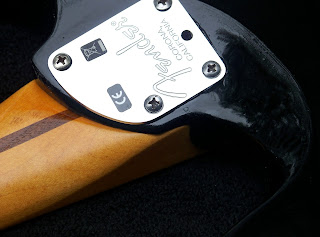

Yes, we thought about it, created it, implemented it and have been doing it for years!
In 1981, Haywire Custom Shop discovered that it was much more comfortable to play high on the neck with this feature. We simply move the Crest of the heel down the fret board approximately 7/8" more into the guitar body. You need the Haywire Recessed Heel Crest option when you're playing at the higher end of the neck past the 12th fret and the bulky heel crest wood blocks your hand. It's especially critical for those players that play more notes high on the neck! Explore more of your guitar. When your fingers can reach more strings and frets, new ideas will open up for you-a Haywire innovation since 1982...................
Improved hand access
Faster playing and more room on the neck
Easier and smoother note bending
Less stress on fingering hand
Cleaner, clearer notes
More responsive hand-tapping
Easier sweep arpeggios
Better trills and hammer-ons
Quicker pull-offs on the high extremes
Ordering From Haywire Custom Guitars
If you would like to order this or any other custom guitar, please contact us and we will be happy to discuss your guitar needs.
You'll have "TOTAL ACCESS" to the neck with our Special "Recessed Heel Crest" modification. A Haywire Recessed Heel Joint Option will let you fly all the way up the entire neck with no road blocks to your playing. You will no longer have to alter your technique to continue playing farther up the neck to reach the high notes.
Sunday, March 6, 2016
Taylor T3 Quilted Maple + Coil Splits on Both Pickups
New Taylor T3 Quilted Maple Top Natural Guitar-Semi-Hollow Body with Dual Humbuckers + Coil Splits on Both Pickups and New Owner Registration Card!
Item: TOT3QNAT
The T3 continues Taylor’s quest to expand the range of tones available to the electric player. Inspired by both the T5 and the Solid Body, Taylor has taken the classic semi-hollowbody sound and applied their signature Taylor design and tonal touches. Taylor has blended their high-definition Style 2 pickups with a coil-splitting application to give players killer humbucker and single coil sounds in one guitar. A push-pull volume and tone knob brings two sweeping modes of tone control.
What’s great about the T3 is the way it soups-up a semi-hollowbody’s essential sound, transforming it into a hot-rod guitar capable of a wider range of tones as a result of Taylor's pickups, coil-splitting, and unique tone control. All on top of signature Taylor traits you can always count on, like superb intonation and easy play-ability.
Serial # 1101295144
Model Year 2014
New Taylor T3 2014 Quilted Maple Top Natural Features:
- Quilted Maple Top
- Solid Sapele Hollowed Body with Sapele Neck
- UV Gloss Natural Body Finish
- White with Black Pinstripe Top Binding
- Venetian Cutaway
- 24 7/8" Scale Length
- 1 11/16" Width Tusq Nut
- 12" Fingerboard Radius
- 21 Fret Ebony Fingerboard
- Clay Dots Inlays
- F Holes with White Binding
- Taylor HD Humbuckers with Coil-splitting Capability
- Taylor Chrome Tuning Machines
- Three-way Switch
- Taylor Adjustable Chrome Bridge and Stop Tail Roller Bridge
Includes:
- Taylor Deluxe T3 Black Hard shell Case
- Taylor Guitars' Limited Lifetime Warranty
- Taylor New Owner Registration Card
Specifications
Shape T3Price $1,265 USBack/Side Wood SapeleTop Wood Figured MapleNeck Wood SapeleElectronics Taylor HD Humbuckers with Coil-splitting Capability
We are experts in the area of Custom Guitar setup, installation, repair, neck fretting, neck refinishing, neck fitting and shaving, alignment, and action adjustment and neck design.
Ebay Store
Ordering From Haywire Custom Guitars
If you would like to order this or any other custom guitar, please contact us and we will be happy to discuss your guitar needs.
Labels:
http://stores.ebay.com/Haywire-Custom-Guitars-Inc?_trksid=p2047675.l2563,
http://www.ebay.com/itm/-/131745018290?,
http://www.haywirecustomguitars.com/default.html
Location:Myrtle Beach,SC
Myrtle Beach, SC, USA
Friday, February 26, 2016
Fill In The Blanks With This Guitar Trivia Quiz and Test Your Knowledge!
1-The Acoustic guitar, originating from ............. has been around since the 1500s.
2-............. acoustical engineer for Gibson, had started marketing a new Spanish style acoustic electric guitar and was famous for mandolin builds, headed the subdivision of Gibson responsible for producing these guitars, named Vivi-Tone
3-Leo Fender had been working on a solid body electric guitar. Fender owned a radio repair shop and started loaning out his invention to musicians in 1943. In 1949, he started marketing the guitar as the ............. which became the first successful solid body electric guitar. This model was then later renamed to "Broadcaster" and then finally to "Telecaster".
4-America's only native instrument is known as the ............ first originated in Africa as the Bania.
5-In 1952, after Leo Fender guitar's success, Gibson began work on the "log" developed by.......... who also used his name for the guitar model produced.
6-In 1955, a Gibson engineer named, ............ invented the Humbucker pickup.
Answers:
1-Spain 2-Lloyd Loar 3-"Esquire" 4-Banjo 5-Les Paul 6-Seth Lover
Ordering From Haywire Custom Guitars
If you would like to order this or any other custom guitar, please contact us and we will be happy to discuss your guitar needs.
Blog Home
Labels:
<img src=" http://www.haywirecustomguitars.com/default.html" alt=" Haywire Custom Guitars USA">,
contactus.html,
https://www.flickr.com/photos/haywirecustomguitars/
Location:Myrtle Beach,SC
Myrtle Beach, SC, USA
Tuesday, February 23, 2016
Why Does My Guitar Need To Be Set Up? All I Did Was Change Strings?
No, of course not! We offer free repair evaluations at the Haywire Custom Guitars-Custom Shop. If electronics need to be accessed to troubleshoot a problem, or if we need to examine an instrument internally for structural issues, no problem-it won't cost you.
There's nothing fun about playing a poorly set up guitar. The strings hurt your fingers, it won't stay in tune, there's buzzing, you can't play with others very well, A bad set up is one of the key reasons new players give up playing guitar. Don't give up! There is lots that can be done. Setups!
Why does my guitar need to be set up?
When you buy a new car don't you need to adjust a car's seat, mirrors and seat belts? A guitar is like any other instrument will need several adjustments too. If it's brand new it will need adjustments for sure! A set up addresses the instrument's play-ability and adjusting many areas to give the guitar a broken in familiar feeling of sheer comfort that makes you want to play it all day! It's simply an extension of YOU, the musician. You want it in top shape!
All I Did Was Change Strings?
Even a simple thing such as changing your strings or gauge can alter the guitar's play-ability, so it may just need a quick tweak. Find a great old guitar at a garage sale or a hand me down from a family member? We'll tweak it to make sure it's playing as well as it possibly can. If you're purchasing a guitar from us, we're happy to set up your instrument exactly the way you'd like. If you're not sure, we can get you going in the right direction and ask a few questions and get it set up well for your comfort and style.
We'll check the: neck relief, nut slot depth and height of the nut, saddle height, intonation, pickup height on electrics, loose and rattling hardware and tighten it back up.
Ordering From Haywire Custom Guitars
If you would like to order this or any other custom guitar, please contact us and we will be happy to discuss your guitar needs.
Blog Home
Labels:
<img src=" http://www.haywirecustomguitars.com,
http://www.haywirecustomguitars.com/services.html,
https://www.flickr.com/photos/haywirecustomguitars/
Location:Myrtle Beach,SC
Myrtle Beach, SC, USA
I need a good acoustic guitar Haywire Custom Guitars offers Premium custom built acoustic guitars and guitar modifications. Haywire Custom Guitars offers Premium custom built guitars and acoustic guitar modifications, setups and repairs. The question that comes up in many guitar discussions is, “What Acoustic Guitar is best? Several acoustic guitar makers build some incredible instruments. A few of these companies are Martin, Guild, Taylor, Gibson and several others like Takamine, Godin, McPherson, Santa Cruz that make incredible guitars as well. These are just a few and there are many independent luthiers in the US and other countries who are regionally know for their high quality instruments. In America it seems the prevailing attitude about almost everything is: more is better, but a good acoustic guitar need not be expensive, however the buyer needs to be alert. A good guitar has a good sound, feel and is comfortable to play. For the most part, the more money you spend, the nicer the acoustic guitar will be. Up to a point then it’s all ego on the part of the guy pricing the guitar after that. Look for a guitar with a straight finger board. Just sight down the neck as if looking down the barrel of a rifle and see if it looks flat, straight with no unusual activity or waviness. Wood is organic and susceptible to climate and humidity changes. A lot can happen after it leaves the bench so be vigilant about finding the flaws BEFORE you buy your acoustic guitar. There are a host of companies that also sell a mid-range value acoustic guitar and very inexpensive guitars, and it is often difficult to decide. Maybe it’s better to list the basic qualities of a good acoustic guitar: 1) All Solid Wood – solid top, solid back and solid sides 2) Light thin finish 3) Scalloped Bracing 4) Exotic woods or even Mahogany with Ebony fret board 5) Bone nut, bridge 6) Large, heavy bridge saddle 7) A straight neck, no buzzing, sturdy hardware, leveled frets There are a few traits that increase the value but not the sound quality of a guitar: 1) Detailed neck or body inlays, special setups, stainless steel frets 2) Unusual transparent stains and finishes 3) Signatures of the makers and letters of authentication Sometimes-you just have to play an acoustic guitar and listen to what you hear. If you love it-That’s the one! It’s not always a matter of making the “right decision”……. It’s making a decision then making it “right”! Haywire Custom Guitars
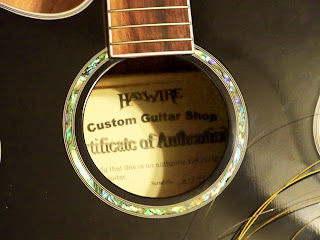
Haywire Custom Guitars offers Premium custom built guitars and acoustic guitar modifications, setups and repairs.
I need a good acoustic guitar
Several acoustic guitar makers build some incredible instruments. A few of these companies are Martin, Guild, Taylor, Gibson and several others like Takamine, Godin, McPherson, Santa Cruz that make incredible guitars as well. These are just a few and there are many independent luthiers in the US and other countries who are regionally know for their high quality instruments. In America it seems the prevailing attitude about almost everything is: more is better, but a good acoustic guitar need not be expensive, however the buyer needs to be alert. A good guitar has a good sound, feel and is comfortable to play.
For the most part, the more money you spend, the nicer the acoustic guitar will be. Up to a point then it’s all ego on the part of the guy pricing the guitar after that. Look for a guitar with a straight finger board. Just sight down the neck as if looking down the barrel of a rifle and see if it looks flat, straight with no unusual activity or waviness. Wood is organic and susceptible to climate and humidity changes. A lot can happen after it leaves the bench so be vigilant about finding the flaws BEFORE you buy your acoustic guitar. There are a host of companies that also sell a mid-range value acoustic guitar and very inexpensive guitars, and it is often difficult to decide.
Maybe it’s better to list the basic qualities of a good acoustic guitar:1) All Solid Wood – solid top, solid back and solid sides
2) Light thin finish
3) Scalloped Bracing
4) Exotic woods or even Mahogany with Ebony fret board
5) Bone nut, bridge
6) Large, heavy bridge saddle
7) A straight neck, no buzzing, sturdy hardware, leveled frets
There are a few traits that increase the value but not the sound quality of a guitar:
1) Detailed neck or body inlays, special setups, stainless steel frets
2) Unusual transparent stains and finishes
3) Signatures of the makers and letters of authentication
Sometimes-you just have to play an acoustic guitar and listen to what you hear.
If you love it-That’s the one!
It’s not always a matter of making the “right decision”……. It’s making a decision then making it “right”!
Haywire Custom Guitars
Blog Home
Labels:
http://www.haywirecustomguitars.com,
http://www.haywirecustomguitars.com/blog.html,
https://www.flickr.com/photos/haywirecustomguitars/
Location:Myrtle Beach,SC
Myrtle Beach, SC, USA
Saturday, February 20, 2016
How Can You Determine The Correct Type Of Strings For Your Guitar?
How Can You Make Sure You Have The Correct Guitar Strings For Your Guitar?
Electric or Acoustic 6 String Guitar? What Do You Have?
 Correct guitar strings-Do you have them?[/caption]If you have an electric guitar, the industry standard is nickel wound and gauge 10-46 is most common for thickness. Electric guitar strings have a different composition than acoustic guitar strings to help the pickups function properly; specifically they have steel core.
Correct guitar strings-Do you have them?[/caption]If you have an electric guitar, the industry standard is nickel wound and gauge 10-46 is most common for thickness. Electric guitar strings have a different composition than acoustic guitar strings to help the pickups function properly; specifically they have steel core. Do you have the right guitar strings?[/caption]For an acoustic guitar, it requires steel strings. Lighter gauge for softer sound and ease of playing. If you want a deeper louder tone, choose heavier (larger) strings. Silk and steel are much easier on the fingers than the regular metal strings but not for use on electric guitars. Bronze strings on an acoustic guitar are standard.
Do you have the right guitar strings?[/caption]For an acoustic guitar, it requires steel strings. Lighter gauge for softer sound and ease of playing. If you want a deeper louder tone, choose heavier (larger) strings. Silk and steel are much easier on the fingers than the regular metal strings but not for use on electric guitars. Bronze strings on an acoustic guitar are standard. Correct guitar strings-Do you have them?[/caption]Nylon guitar strings have a soft, mellow tone, are easy on the fingers and designed for classical guitar. Ball-end nylon strings, sometimes called "folk nylon," are a little heavier than regular nylon can stand vigorous strumming.
Correct guitar strings-Do you have them?[/caption]Nylon guitar strings have a soft, mellow tone, are easy on the fingers and designed for classical guitar. Ball-end nylon strings, sometimes called "folk nylon," are a little heavier than regular nylon can stand vigorous strumming.
Strings for a Jazz box are sometimes flat-wound
Flat-wound strings can be used for any electric guitar. They are comfortable on the chord hand and give a smooth "thuddy" tone when amplified. This string is preferred by many jazz guitarists. Flat-wound strings will provide a more mellow tone than a similar round-wound string, they will also be harder to grip with your fingers during bends and fretting.
Ordering From Haywire Custom Guitars
If you would like to order this or any other custom guitar, please contact us and we will be happy to discuss your guitar needs.
Blog Home
Labels:
<img src=" http://www.haywirecustomguitars.com/default.html" alt=" Haywire Custom Guitars USA">,
http://www.haywirecustomguitars.com/blog.html
Location:Myrtle Beach,SC
Myrtle Beach, SC, USA
Wednesday, February 17, 2016
The Stratocruiser & Stratoliner Remembered by Haywire Custom Guitars

Enclosed is an excerpt from a History Snapshot at and from Boeing. We try and remember how names of things come to be.....
"After World War II, Boeing reentered the commercial
market with a new long-range airliner, the Stratocruiser (Model 377). It
was the first Boeing commercial transport since the Stratoliner, and
like its military counterpart, the C-97, was based on the B-29 Bomber. It possessed all the speed and technical improvements available to bombers at the end of the war.
The Stratocruiser set a new standard for luxurious air travel with
its tastefully decorated extra-wide passenger cabin and gold-appointed
dressing rooms. A circular staircase led to a lower deck beverage
lounge, and flight attendants prepared hot meals for 50 to 100 people in
a state-of-the-art galley. As a sleeper, the Stratocruiser was equipped
with 28 upper-and-lower bunk units.
Pan American placed the first order for 20 Stratocruisers, worth $24
million, and they began service between San Francisco, Calif., and
Honolulu, Hawaii, in 1949. Boeing built 56 Stratocruisers between 1947
and 1950. The airplane marked the company's first significant success
selling passenger planes to airlines in other countries.
During the early 1960s, Aero Space Lines ballooned the
Stratocruiser's fuselage into a whale-like shape to carry spacecraft
sections. Nine of the variants were assembled. The first was called the
"Pregnant Guppy," followed by five larger "Superguppies" and three
smaller "Miniguppies."
| First flight | July 8, 1947 |
| Model number | 377 |
| Classification | Commercial transport |
| Span | 141 feet 3 inches |
| Length | 110 feet 4 inches |
| Gross weight | 145,000 pounds |
| Top speed | 375 mph |
| Cruising speed | 300 mph |
| Range | 4,600 miles |
| Ceiling | More than 33,000 feet |
| Power | Four 3,500-horsepower P&W R-4360 Wasp Major engines |
| Accommodation | 55 to 100 passengers and attendants |
Blog Home
New Mobile Site Here @ Haywire Custom Guitars !

Ordering From Haywire Custom Guitars
If you would like to order this or any other custom guitar, please contact us and we will be happy to discuss your guitar needs.
Blog Home
Labels:
<img src=" Custom Guitars USA">,
<img src=" http://www.haywirecustomguitars.com/default.html" alt=" Haywire Custom Guitars USA">,
http://www.haywirecustomguitars.mobi/
Location:Myrtle Beach,SC
Myrtle Beach, SC, USA
Tuesday, February 16, 2016
So, you want new pickups? No Problem, we'll put them in for you-$25 per pickup labor.
So, you want new pickups?
At Haywire Custom Guitars-It's no problem, we'll put
them in for you-$25 per pickup labor. We'll add any pickups that you
want! We've got them-all- Bartolini, EMG, Lollar, DiMarzio, Fender, Duncan, Bare
Knuckle, TV Jones, Fishman, Frahlin and many more Whatever you want or
we can suggest something!
Ordering From Haywire Custom Guitars
If you would like to order this or any other custom guitar, please contact us and we will be happy to discuss your guitar needs.
Blog Home
Monday, February 15, 2016
Wouldn't it Be Great to Be Able to Buy a Guitar That Felt Gig Ready Right Out of the Box?
Gig-Ready Guitars
By: Richard Mariner

Author and Founder of Haywire Custom Guitars Inc.

Rick Mariner working on a guitar issue. Update: fixed!
I love gig-ready guitars, and there’s nothing like a new electric guitar with a proper set up! I like the tone, the way it feels in my hands, and the way it can sound “right” for any kind of music. Whether it’s jazz, blues, country, hard rock, R & B leads, guitar chords, or just working on songs, all it takes is a flip of a switch, some prep, a couple twists of the knobs, neck alignment and I’m right where I need to be.
After working on a lot of guitars over the years, I discovered that taking that beautiful new Strat or Tele guitar out of the box was always just the first step in finding the gig-ready guitars that fit in my hands the way that I imagined they would when they first caught my eye. After a close inspection my new guitar wouldn’t be a gig-ready guitar until I did all of the little subtle tweaks, repairs and modifications that would make it play just the way it should for me out on the gig. Dress the frets, get the intonation just right, tweak the pick-ups, customize the configuration a bit, and before you know it, I’d be playing a guitar that felt like it was made to be in my hands. Playing music is always fun, but when I’m on the gig with a guitar that feels just right… it’s just pure guitar joy.
“Wouldn’t it be great to be able to buy gig-ready guitars that felt gig ready right out of the box?” As wonderful as that idea may seem, in reality it’s almost impossible to pick up a guitar in a music store “off the rack” and have it play right. It just doesn’t happen. There are many things that need to be done to “prep” the guitar before it’s ready to play. At Haywire Custom Shop we recommend and perform all of the following in prep for a guitar purchase before it leaves the bench at the workshop. For our purposes here I will focus only on electric instruments for now. First, let me pose a question to the beginning through the advanced guitarist.
What Is Guitar Intonation and why is it important? Do you know?
Intonation is the accuracy in which an electric guitar or bass can produce a fretted note and the most important issue with any instrument. Setting the intonation on a guitar is the act of adjusting the length of the strings (by moving the bridge saddles) to compensate for the thickness of the string and the stretching of a string due to pushing it down to the fret board to produce a note. To adjust the intonation of your guitar or bass guitar, you move the bridge saddles toward or away from the fret board until the 12th fret note and its harmonic are equal in pitch to the same open-string note, which are exactly one octave apart. Accurate intonation is critical to pitch quality. Pitch quality is essential to “in tune” playing. Poor pitch quality=”out of tune” notes which in turn = poor musical presentation. Wouldn’t you want to present your musical talents in the best way possible? Of course, you do.
Now, it is not necessary for a guitar player to know this at all. It is essential however that the guitar possess this quality and maintain as close to perfect intonation as possible. Buying on looks alone can be very disappointing. If however, you like an instrument for the looks but realize that you will need to have it worked on to get it playable then that is a savvy notion. It’s best to speak to a guitar tech, repair expert or guitar builder previous to any purchase. It’s akin to asking a mechanic which car he would recommend-before you walk into the show room. In this way you can benefit from his first hand knowledge and experience and not have to go it alone. After all he sees the ones that breakdown more often than you or the car salesmen do.
Below, are outlined the essential adjustments to be performed prior to purchasing and playing gig-ready guitars under optimal circumstances.
1. 4-axis Alignment of the guitar neck.
The guitar neck is checked and adjusted to insure that it is true and straight to insure proper alignment on all axis. This step insures proper action and allows for more accurate and easier guitar tuning, playing and set-up in the following steps.
2. Inspect and Lube the guitar tuning gears.
Each tuning gear is adjusted so that there is no play in the mechanism. They are then lubricated to insure smooth and even movement to make your guitar tune accurately.
3. Potting the guitar pickups.
Dip the pickups in hot wax to reduce squeal and unwanted guitar feedback.
4. Prep the guitar body.
Upon installing the guitar electronic components, great care is taken to insure that all wires are properly routed, spaced, and grounded to insure years of trouble free service with your guitar.
5. Level and polish the frets.
This insures that all of the guitar frets are level, eliminating any possibility of fret buzz due to unevenness.
6. Radius the guitar strings.
Most guitar necks have a contour over the top of the neck called the “radius”. Adjust the strings to make sure the height of each string follows the contour of the guitar neck.
7. Adjusting the overall guitar string height and the action.
Once the string contour and radius of the guitar strings is set, it’s time to adjust the overall height or “action” or distance of the strings from the top of the frets to the bottom of the guitar strings.
8. Set the guitar intonation
This step should be done twice. The intonation is normally set two times with a 24 hour period in between to allow the new guitar adjustments to properly re-seat.
If these steps are performed before playing your new guitar then, you won’t be disappointed. Your focus can then be on the music and not the problems of the instrument. If it is “set up” properly a player will not have to “get used to” it. Everything on it will feel natural and fall right into place and the music can flow so you can lay back deep in the groove and just play………..
In summary, Guitar purchase “off the rack” can be a real disappointment. A thoughtful purchase should include consideration in buying a “custom” or “gig-ready guitars” electric guitar versus a “pre-fab” instrument built on a production line. Custom guitars are individually built for a specific customer and will have all of the above necessary operations performed. All the guitarist needs to do is-Play!
Rick Mariner – Owner and founder of Haywire Value Priced Custom Guitars ( http://www.HaywireCustomGuitars.com
) and a member of The Association of Stringed Instrument Artisans
(A.S.I.A.) as well as a guitar player. He holds a bachelors degree from
University of Md. and a Masters degree from George Washington
University.
Haywire developed an 8 – Point “Gig- Ready” guitar process that allows for Haywire Custom Guitars gig-ready guitars. With many years of development and guitar set-up experience, we pride ourselves in helping to build you the “Just Right” Haywire guitar for you at prices well below market.
Haywire developed an 8 – Point “Gig- Ready” guitar process that allows for Haywire Custom Guitars gig-ready guitars. With many years of development and guitar set-up experience, we pride ourselves in helping to build you the “Just Right” Haywire guitar for you at prices well below market.
Ordering From Haywire Custom Guitars
If you would like to order this or any other custom guitar, please contact us and we will be happy to discuss your guitar needs.
Blog Home
Saturday, February 13, 2016
Urgent Care Repost: How To Straighten A Guitar Neck With An Adjustable Truss Rod
Updated on Feb. 14, 2012
Angled Head-stock style of adjustable truss rod

Angled Headstock style of adjustable truss rod
The neck of your guitar is adjustable
In
most cases, the neck of a guitar is adjustable. Although the wood is
generally hard, dry and stiff it will still bend with string pressure
and humidity or lack thereof. In our shop we have to deal with that
issue on a daily basis. Inside the neck is a routed channel between the
finger board and the neck shaft where a truss rod is placed to
compensate for movement on the forward axis of the neck to add
stability. The rod is steel and is adjustable. It runs the length of the
guitar neck with an opening at one end allowing for adjustments.
The truss rod both strengthens the neck and facilitates an adjustment called "relief" in the neck. A bowed or humped neck can be reversed with skillful manipulation by the adjuster-you. All guitar necks are subject to great stress. This is sometimes the result of seasonal change, Other times when a neck could take on a slight bow or hump are from string changes with gauges higher than normally used. A guitar player will usually know a little about how to make some adjustments on his guitar. Some things however may contribute to a misaligned neck.
Several of the "usual problems" seen are heavier gauge strings which increases the forward pressure, removing all of the strings at once and leaving guitars in a hot car. These actions will cause immediate negative pull and the will revert naturally back to where it started. However, if it does, there is a solution if you follow the procedure below for proper re-positioning of a bowed neck. In our Custom shop this is the procedure we use.
First, loosen all the strings but you will not have to remove them. Push the loose strings to one side to gain access to neck adjuster. Remove cover, so neck adjuster is exposed. It's either an Allen screw or a hex nut. Look down the neck from the top where the tuners are located towards the bridge (similar to sighting a down the barrel of a gun) to see how much of a bow or hump the neck has in it.
It is recommended to use a Notched Straightedge to see how far out of alignment the neck really is. The notches are on both side of the tool. One side has cutouts for a 24-3/4" scale neck and the other is for the most common 25-1/2" scale. They are there so frets can be avoided when the tool comes in contact with the fret board. The frets fit neatly in the cut out and the straight edge will show any problems when it lies straight on the fret board.
At this point, if it is discovered that the neck is out of adjustment, it's time to go to work. Insert the Allen key or hex wrench in the Allen slot or on the adjustment nut and turn very gently in small increments at a time. Checking the neck as you proceed with each nut turn is required. Once the neck is straight keep adjusting a bit more to compensate for the tension the stings will add once they are re-tuned to pitch. Turn right or clockwise for " BOW " alternately left or counterclockwise for a HUMP. Take special care as not to tighten the nut too much because it could result in a broken truss rod, stripped threads and a much larger monetary outlay than originally intended.
This should fix the problem! If there seems to be an inordinate amount of "string buzz" that you find impossible to live with bring it in to your guitar tech for further inspection. If the neck has a "twist" it can void the neck straightening process you have just used and will need attention from a Luthier.
On some "Vintage Guitars" the adjustment is the same but in a different location. It is made at the end of the fingerboard called the Heel or Butt end.
The truss rod both strengthens the neck and facilitates an adjustment called "relief" in the neck. A bowed or humped neck can be reversed with skillful manipulation by the adjuster-you. All guitar necks are subject to great stress. This is sometimes the result of seasonal change, Other times when a neck could take on a slight bow or hump are from string changes with gauges higher than normally used. A guitar player will usually know a little about how to make some adjustments on his guitar. Some things however may contribute to a misaligned neck.
Several of the "usual problems" seen are heavier gauge strings which increases the forward pressure, removing all of the strings at once and leaving guitars in a hot car. These actions will cause immediate negative pull and the will revert naturally back to where it started. However, if it does, there is a solution if you follow the procedure below for proper re-positioning of a bowed neck. In our Custom shop this is the procedure we use.
First, loosen all the strings but you will not have to remove them. Push the loose strings to one side to gain access to neck adjuster. Remove cover, so neck adjuster is exposed. It's either an Allen screw or a hex nut. Look down the neck from the top where the tuners are located towards the bridge (similar to sighting a down the barrel of a gun) to see how much of a bow or hump the neck has in it.
It is recommended to use a Notched Straightedge to see how far out of alignment the neck really is. The notches are on both side of the tool. One side has cutouts for a 24-3/4" scale neck and the other is for the most common 25-1/2" scale. They are there so frets can be avoided when the tool comes in contact with the fret board. The frets fit neatly in the cut out and the straight edge will show any problems when it lies straight on the fret board.
At this point, if it is discovered that the neck is out of adjustment, it's time to go to work. Insert the Allen key or hex wrench in the Allen slot or on the adjustment nut and turn very gently in small increments at a time. Checking the neck as you proceed with each nut turn is required. Once the neck is straight keep adjusting a bit more to compensate for the tension the stings will add once they are re-tuned to pitch. Turn right or clockwise for " BOW " alternately left or counterclockwise for a HUMP. Take special care as not to tighten the nut too much because it could result in a broken truss rod, stripped threads and a much larger monetary outlay than originally intended.
This should fix the problem! If there seems to be an inordinate amount of "string buzz" that you find impossible to live with bring it in to your guitar tech for further inspection. If the neck has a "twist" it can void the neck straightening process you have just used and will need attention from a Luthier.
On some "Vintage Guitars" the adjustment is the same but in a different location. It is made at the end of the fingerboard called the Heel or Butt end.
Haywire Custom Guitars "Violator"

Ordering From Haywire Custom Guitars
If you would like to order this or any other custom guitar, please contact us and we will be happy to discuss your guitar needs.
Blog Home
Labels:
<img src=" Custom Guitars USA">,
<img src=" http://www.haywirecustomguitars.com/default.html" alt=" Haywire Custom Guitars USA">,
custom guitar by Haywire
Location:Myrtle Beach,SC
Myrtle Beach, SC, USA
Wednesday, February 10, 2016
Why Is My Acoustic Guitar So Hard to Play? I Just Bought It!
The problem with a NEW guitar especially an acoustic is that it's NEW! A new acoustic leaves the factory with very high action and it is not meant to be played until it's set up correctly. It's stiff, tight, hard to play and makes your fingers hurt. The store is supposed to tell you-but sometimes they don't know because no one told THEM.
The guitar factories typically put out guitars day after day and they never know who it's going to end up with them. They'll say, "Well, we don't set them with low action because we don't know if possibly a slide player, who for the most part like higher action, may purchase it". Sure we get that. However you really need to relay that kind of info to the stores and players and perhaps give them an option to have a similar model side by side with it to be set up for lower action so customers have a choice-high or low action. We get calls like this all the time from customers indicating-"Hey, it's NEW". "Why is it so hard to play?"
So....what does an acoustic player do? The best way to deal with it is to contact an independent custom guitar shop to have the action set exactly, where they need it to be. In our Custom Shop in South Carolina we typically have the customer drop it off or ship it with instructions on how he wants it to play, we'll work on it. When he or she comes back to pick it up-we'll ask them to test it out. If it's fine-that's great! If it needs more work to make it comfortable for them then we'll tweak anything that needs to be done to get it where they want it to be while they're right there to test it so they won't have to come back again with the same problem.
While a NEW acoustic can look beautiful on the wall in the store it may need lots of work to get it where the players needs it to be. An acoustic guitar should play with ease and sound great. The player shouldn't need to think about the difficulty of playing but rather about entertaining and getting their musical point across and creating the mood for the gig. There is hope. You don't have to sell your guitar or return it but you need to have it set up properly for YOUR style of playing to be happy. We'll do it for you, just bring it in. Typically a day turnaround time will get you going and playing comfortably and your fingers will thank you.
843-347-5742

This
is a QR Code for HAYWIRE CUSTOM GUITARS INC.. If you have a QR Code
scanning app, you can simply scan this image to have this business's
information displayed on your phone.
Blog Home
Subscribe to:
Posts (Atom)
